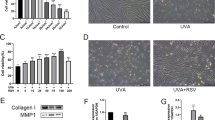Abstract
We investigated the protective effect of aqueous-methanol extract of laver (Porphyra yezoensis) against UV-induced damage in HaCaT cells. The laver extract exhibited strong UV absorbance at 300–360 nm. The cells irradiated with UVA or UVB in the presence of the extract exhibited higher viability than those irradiated without the extract. The protective effect was more prominent against UVA probably due to stronger absorption and screening of the UVA. The laver extract also exerted cell-protective effect in the postirradiation period. The extract increased steady-state glutathione content of HaCaT cells. The cells irradiated with UVA in the presence of the laver extract exhibited less severe depletion of glutathione than those irradiated without the extract. The extract also stimulated recovery from UVA-induced glutathione depletion in the post-irradiation period, which supports a critical role of oxidative stress in the UVA-induced cell damage and also a role of the laver extract in the antioxidative defense.
Similar content being viewed by others
References
Cho, J. W. et al. Curcumin inhibits the expression of COX-2 in UVB-irradiated human keratinocytes (HaCaT) by inhibiting activation of AP-1: p38 MAP kinase and JNK as potential upstream targets. Exp. Mol. Med. 37, 186–192 (2005).
Rundhaug, J. E. & Fischer, S. M. Cyclo-oxygenase-2 plays a critical role in UV-induced skin carcinogenesis. Photochem. Photobiol. 84, 322–329 (2008).
Yaar, M. & Gilchrest, B. A. Photoageing: mechanism, prevention and therapy. Br. J. Dermatol. 157, 874–887 (2007).
Armstrong, B. K. & Kricker, A. The epidemiology of UV induced skin cancer. J. Photochem. Photobiol. B. 63, 8–18 (2001).
Diffey, B. L. Ultraviolet radiation and human health. Clin. Dermatol. 16, 83–89 (1998).
Besaratinia, A. et al. DNA lesions induced by UV A1 and B radiation in human cells: comparative analyses in the overall genome and in the p53 tumor suppressor gene. Proc. Natl. Acad. Sci. USA 102, 10058–10063 (2005).
Pfeifer, G. P., You, Y. H. & Besaratinia, A. Mutations induced by ultraviolet light. Mutat. Res. 571, 19–31 (2005).
Setlow, R. B. & Carrier, W. L. Pyrimidine dimers in ultraviolet-irradiated DNA’s. J. Mol. Biol. 17, 237–254 (1966).
Ehrhart, J. C., Gosselet, F. P., Culerrier, R. M. & Sarasin, A. UVB-induced mutations in human key gatekeeper genes governing signalling pathways and consequences for skin tumourigenesis. Photochem. Photobiol. Sci. 2, 825–834 (2003).
Shorrocks, J., Paul, N. D. & McMillan, T. J. The dose rate of UVA treatment influences the cellular response of HaCaT keratinocytes. J. Invest. Dermatol. 128, 685–693 (2008).
Assefa, Z., Van Laethem, A., Garmyn, M. & Agostinis, P. Ultraviolet radiation-induced apoptosis in keratinocytes: on the role of cytosolic factors. Biochim. Biophys. Acta 1755, 90–106 (2005).
Bickers, D. R. & Athar, M. Oxidative stress in the pathogenesis of skin disease. J. Invest. Dermatol. 126, 2565–2575 (2006).
Stern, R. S., Weinstein, M. C. & Baker, S. G. Risk reduction for nonmelanoma skin cancer with childhood sunscreen use. Arch. Dermatol. 122, 537–545 (1986).
Thompson, S. C., Jolley, D. & Marks, R. Reduction of solar keratoses by regular sunscreen use. N. Engl. J. Med. 329, 1147–1151 (1993).
Kulms, D. & Schwarz, T. Molecular mechanisms of UV-induced apoptosis. Photodermatol. Photoimmunol. Photomed. 16, 195–201 (2000).
Moan, J., Porojnicu, A. C. & Dahlback, A. Ultraviolet radiation and malignant melanoma. Adv. Exp. Med. Biol. 624, 104–116 (2008).
Zhang, L., Li, L. & Wu, Q. Protective effects of mycosporine-like amino acids of Synechocystis sp. PCC 6803 and their partial characterization. J. Photochem. Photobiol. B. 86, 240–245 (2007).
Sinha, R. P., Klisch, M., Gröniger, A. & Häder, D.-P. Ultraviolet-absorbing/screening substances in cyanobacteris, phytoplankton and macroalgae. J. Photochem. Photobiol. B. 47, 83–94 (1998).
Conde, F. R., Churio, M. S. & Previtali, C. M. The photoprotector mechanism of mycosporine-like amino acids. Excited-state properties and photostability of porphyra-334 in aqueous solution. J. Photochem. Photobiol. B. 56, 139–144 (2000).
Whitehead, K. & Hedges, J. I. Photodegradation and photosensitization of mycosporine-like amino acids. J. Photochem. Photobiol. B. 80, 115–121 (2005).
Helbling, E. W., Menchi, C. F. & Villafane, V. E. Bioaccumulation and role of UV-absorbing compounds in two marine crustacean species from Patagonia, Argentina. Photochem. Photobiol. Sci. 1, 820–825 (2002).
Yuan, Y. V. & Walsh, N. A. Antioxidant and antiproliferative activities of extracts from a variety of edible seaweeds. Food Chem. Toxicol. 44, 1144–1150 (2006).
de la Coba, F, Aguilera, J., Figueroa, F. L., de Gálvez, M. V. & Herrera, E. Antioxidant activity of mycosporine-like amino acids isolated from three red macroalgae and one marine lichen. J. Appl. Phycol. 21, 161–169 (2009).
Groniger, A., Sinha, R. P., Klisch, M. & Hader, D. P. Photoprotective compounds in cyanobacteria, phytoplankton and macroalgae-a database. J. Photochem. Photobiol. B. 58, 115–122 (2000).
Yildiza, G., Vatana, Ö., Çeliklera, S. & Derea,. Determination of the phenolic compounds and antioxidative capacity in red algae Gracilaria bursa-pastoris. Int. J. Food Prop. 14, 496–502 (2011).
Cornich, M. L. & Garbary, D. J. Antioxidants from macroalgae: potential applications in human health and nutrition. Algae 25, 155–171 (2010).
Klisch, M. & Hader, D. P. Wavelength dependence of mycosporine-like amino acid synthesis in Gyrodinium dorsum. J. Photochem. Photobiol. B. 66, 60–66 (2002).
Torres, A., Enk, C. D., Hochberg, M. & Srebnik, M. Porphyra-334, a potential natural source for UVA protective sunscreens. Photochem. Photobiol. Sci. 5, 432–435 (2006).
Reed, D. J. et al. High-performance liquid chromatography analysis of nanomole levels of glutathione, glutathione disulfide, and related thiols and disulfides. Anal. Biochem. 106, 55–62 (1980).
Lowry, O. H., Rosebrough, N. J., Farr, A. L. & Randall, R. J. Protein measurement with the Folin phenol reagent. J. Biol. Chem. 193, 265–275 (1951).
Author information
Authors and Affiliations
Corresponding author
Rights and permissions
About this article
Cite this article
Yang, SJ., Han, T. & Choi, EM. The protective effect of laver extract against the UVA- and UVB-induced damage in HaCaT cells. Toxicol. Environ. Health Sci. 4, 186–193 (2012). https://doi.org/10.1007/s13530-012-0134-5
Received:
Revised:
Accepted:
Published:
Issue Date:
DOI: https://doi.org/10.1007/s13530-012-0134-5




